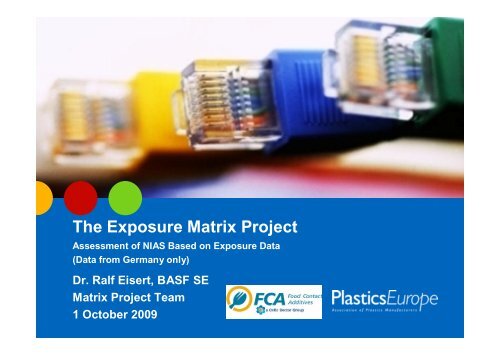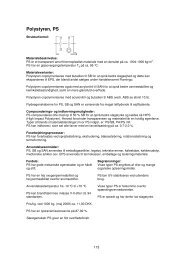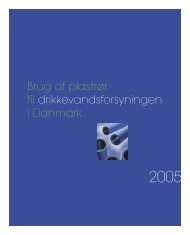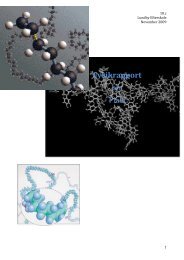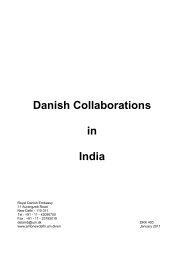The Exposure Matrix Project
The Exposure Matrix Project
The Exposure Matrix Project
- No tags were found...
Create successful ePaper yourself
Turn your PDF publications into a flip-book with our unique Google optimized e-Paper software.
<strong>The</strong> <strong>Exposure</strong> <strong>Matrix</strong> <strong>Project</strong>Assessment of NIAS Based on <strong>Exposure</strong> Data(Data from Germany only)Dr. Ralf Eisert, BASF SE<strong>Matrix</strong> <strong>Project</strong> Team1 October 2009
Assessment/Evaluation CascadeMonomer(s) listedAdditives listedSMLs applicablePotential CRM substances addressedNIAS via LOI conceptClearance2
Obligation for Producers of FoodContact Materials• “Declaration of Compliance” Art. 16 of Reg. 1935/2004/EC, Art.9 & Annex VII of Dir. 19/2007/EC.• “Record keeping” Art. 16 of Reg. 1935/2004/EC Art. 9.3 of Dir.19/2007/EC:Appropriate documentation to demonstrate that the materials and articles aswell as the substances intended for the manufacturing of those materials andarticles comply with the requirements of this Directive shall be made availableby the business operator to the national competent authorities on request.That documentation shall contain the conditions and results of testing,calculations, other analysis, and evidence on the safety or reasoningdemonstrating compliance.’3
<strong>The</strong> <strong>Matrix</strong> <strong>Project</strong>:Objective:Developing a tool for risk assessment of NIAS in (plastic) foodcontact materials and articles, based on exposure.5
<strong>Project</strong> Sponsors‣ Plastics Europe‣ EuPC‣ FPE‣ CeficFCACosts: 600.000 Euros6
Forest of Peaks<strong>The</strong> Forest of Peaks includes both known and unknown substances.10.0 uV(x10,000)9.0Chromatogram8.0IS7.06.05.04.03.02.01.00.01.00.0 2.5 5.0 7.5 10.0 12.5 15.0 17.5 20.0 22.5 25.0 27.5 30.0 32.5 35.0 37.5 min7
<strong>The</strong> General Approach‣ Can we predict all the NIAS: NO!Most sophisticated attempts (CSL, TNO) could predictroughly half of them.‣ <strong>The</strong>refore the most comprehensive way is Migrations +concentration + gas chromatography forest of peaksBUT8
Defining the LOI‣ If one knows the surface of a given material to which one consumer is exposedthrough his daily diet, it is clear that his exposure to any substance migratingfrom this surface is:<strong>Exposure</strong> = Migration x Surface<strong>Exposure</strong> [µg/person/day] = Migration [µg/dm 2 ] x S [dm 2 /person/day]If one fixes a tolerable level of exposure TEL for NIASTEL (NIAS) max. migration = tolerable for this material = LOIS and this consumer‣ This needs of course to be estimated for the whole population.<strong>The</strong> surfaces to which the consumers are exposed are obtained by combiningthrough probabilistic modeling the weights of each food ingested by a populationwith the surfaces of packaging materials in contact with the unit weightof these respective foods10
<strong>The</strong> Level Of Interest (LOI)10.0 uV(x10,000)ChromatogramLOI9.08.0IS7.06.05.04.0If the migration < LOIrisk is considerednegligible3.02.01.00.01.00.0 2.5 5.0 7.5 10.0 12.5 15.0 17.5 20.0 22.5 25.0 27.5 30.0 32.5 35.0 37.5 min11
Data Input & Probabilistic Approachto Obtain the LOIsFood intake studies‣ National food intake studies providedaily intakes (g) per food item.Food packaging dataProbabalistic modelling‣ Packaging databases deliverpackaging surfaces per food item andpackaging material (e.g. surface in m²of PET used for packaging of nonalcoholicbeverages),‣ Run a probabilistic combination of databy the MonteCarlo method which willdeliver for each couple food/packagingthe areas of material to which theconsumers are exposed through theirdaily diet.For the <strong>Matrix</strong> based on data from Germany, we fixed 51 foodclasses and 54 packaging materials.12
Information collected to get the LOIs: an extractfrom the GVM data base –packaging surfacesPackaging consumption withdirect food contact inGermany relevant parameter:packaging surface 2003,packaging < = 6,5 kg nominalcontentsby material typesdifferentiated after maincomponents and sidecomponentspackagingsurface1.000 m²aluminium foilother packagingnonplastic/plastic, plastic >5%mass share without liquid cartonVLDPE or LLDPE and blends withLDPELDPEfilling groupstotal1. alcoholic beveragesincluding wines, beers andliquors 16.407 0 0 0 0 0 0 0 0 0 0 0 88 0 0 790 0 0 0 0 0 0 0 0 0 0 0 0 0 0main component 16.319 0 0 0 0 0 0 0 0 0 0 0 0 0 0 79closures or other side components 89 0 0 0 0 0 0 0 0 0 0 0 88 0 0 02. nonalcoholic nondairybeverages including waters,juices and soft drinks 966.830 0 0 2.804 0 274 0 4.123 0 1.003 0 0 2.795 0 0 634.8810 0 0 0 0 0 0 0 0 0 0 0 0 0 0main component 957.107 0 0 0 0 274 0 0 0 1.003 0 0 0 0 0 634.881closures or other side components 9.724 0 0 2.804 0 0 0 4.123 0 0 0 0 2.795 0 0 03. concentrates of juicesand soft drinks; syrups fordilution 793 0 0 0 0 0 0 4 0 0 0 0 22 0 0 7290 0 0 0 0 0 0 0 0 0 0 0 0 0 0main component 769 0 0 0 0 0 0 3 0 0 0 0 0 0 0 729closures or other side components 24 0 0 0 0 0 0 1 0 0 0 0 22 0 0 04. liquid coffee or teapreparations 158 0 0 0 0 0 0 7 0 0 0 0 0 0 0 1510 0 0 0 0 0 0 0 0 0 0 0 0 0 0main component 151 0 0 0 0 0 0 0 0 0 0 0 0 0 0 151closures or other side components 7 0 0 0 0 0 0 7 0 0 0 0 0 0 0 05. dry coffee, tea, cocoapowder, dry beverage powders 166.226 0 0 13.964 0 0 0 0 0 0 15.812 0 239 0 0 3.169acid+ester copolymers (EVA, EMA,EAA, EBA)HDPEother PE based blendsmultilayer PEOPPmetallized OPPother PPPAPCPET (CPET and APET)13
Information collected to get the LOIs: anextract from the BfR report –daily intakes (g)All population Consumers onlyFood itemsMean Median 95th % ofMean Median 95thperc. cons.perc.1. alcoholic beverages including wines,beers and liquors220 82 917 93% 236 99 9432. nonalcoholic nondairy beveragesincluding waters, juices and soft drinks997 866 2186 100% 997 866 21863. concentrates of juices and soft drinks;syrups for dilution0 0 0 0% 27 27 274. liquid coffee or tea preparations 5. dry coffee, tea, cocoa powder, drybeverage powders17 14 40 97% 17 15 406. cereals, unprocessed or puffed;cereal flakes or bars; breakfast cerealsand muesli11 0 67 34% 31 17 105N.B.: <strong>The</strong>se mean values are higher than the median, therefore they cover morethan 50% of the population and take into account the extreme consumers.14
Probabilistic Approachto Generate the LOIsRun a probabilistic combination of data by the MonteCarlomethod which will deliver for each couple food/packaging theareas of material to which the consumers are exposed throughtheir daily diet.15
Determination of Surfacesto which Consumers are Exposed• Dietary intake study for Germany obtained by BfR fromRobert Koch Institute (study on German adults)• Probabilistic model run by BfR supposing all consumedfoods are packaged and 100% packaging loyalty (overestimation)• Results given for each “cell”or combination of one foodgroup with one packaging material• As the sum of all surfaces determined for one material incontact with all the foods for which it is used is the criticalparameter, only figures corresponding to the mean values areusable16
Determination of Surfacesto which Consumers are Exposed• Results are overestimated because any NIAS is supposed tohave the same potential migration for any type of food.• In reality migration depends on the fraction of surfaces incontact with aqueous and fatty foods of the daily diet.• We consider simulants as fixed in Directive 85/572/EEC. Thisleads to attribute the surfaces in each cell to one or severalsimulants.• We make the sums of surfaces in contact with foodssimulated by A or B or C, and the sums of surfaces in contactwith D (some double counting occurs).17
Probabilistic Approach to Generate the LOIs:Surfaces (dm 2 per person per day)18
Probabilistic Approach to Generate the LOIs:Surfaces (dm 2 per person per day)Description of approach:Look seperately at sum simulant A/B/C and sum simulant DLDPE: sum of columns LDPE+ other PE based blends + liquid cartons +Half of all multisubstrate multilayers with PE as food contactLLDPE: Sum of VLDPE or LLDPE and blends with LDPE + Half of all multisubstratemultilayers with PE as food contact layerWe fixed TELNIAS at 10 µg/person/day; this is the exposurecorresponding to the 10 ppb migration when using the presentconventions, and which are tolerated for a non listed additive behind afunctional barrier19
Probabilistic Approach to Generate the LOIs:Surfaces (dm 2 per person per day) for PolymersMaterialaqueousdm²/p/dayfatdm²/p/dayMaterialaqueousdm²/p/dayfatdm²/p/dayLDPE 2,4 2 PA 0 0LLDPE 1,25 1,25 PC 0 0,001HDPE 0.409* 0.409* PS 0,355 0,498Ethylene copolym. 0.023* 0.023* EPS 0,315 0,315PP (incl. OPP) 0,708 2,042 PET 2,496 0,108PVC + PVDC 0.182* 0.182* Ionomers 0,134 0,12820
<strong>The</strong> LOIs values for plastic producersMaterialaqueousµg/dm²fatµg/dm²Materialaqueousµg/dm²fatµg/dm²LDPE 4 5 PA 100 100LLDPE 8 8 PC 100 100HDPE 25 25 PS 28 20Ethylene copolym. 100 100 EPS 30 30PP (incl. OPP) 14 5 PET 4 10PVC + PVDC 55* 55* Ionomers 75 75N.B.:For the materials to which the exposure is low to negligible (S 100), it is suggested to apply aconventional LOI of 100* Figure derived from total surface in contact with foods due to high values corresponding to simulant 021
Practical Use of LOI Values for PlasticsProducersRun migrations in aqueousand fatty simulantRun the migrations under appropriate conditionsfollowing the Directive 82/711/EEC as amendedor use modeling based on residualsObtain „forest of peaks“Obtain the “forest of peaks”by e.g. gaschromatography using FID and an internalstandard or any other acceptable analyticalmethod Standard procedures will be developedas guidelinesTrace the LOITrace on each “chromatogram”the linecorresponding to the LOIEach company should feel free to use moresevere/lower LOIs if desired or lesssevere/higher LOIs if they are convinced theycan justify it22
<strong>The</strong> Level Of Interest (LOI)10.0 uV(x10,000)ChromatogramLOI9.08.0IS7.06.05.04.0If the migration < LOIrisk is considerednegligible3.02.01.00.01.00.0 2.5 5.0 7.5 10.0 12.5 15.0 17.5 20.0 22.5 25.0 27.5 30.0 32.5 35.0 37.5 min23
Practical Use of LOI Values for PlasticsProducers• Any peak above the LOI should be further assessed.• Peaks below the LOI do not need further assessment.However this should not replace the standard control ofsubstances with SMLs if any.24
Remarks• Although aiming essentially at the assessment of NIASthe LOI approach is offering also an important informationfor justification of compliance with the article 3 for theNon Listed Substances (NLS) in EU Directives such asPPAs, solvents, catalysts, …• Indeed, we have the indication that for all the NLS below LOIthe exposure of the consumers are in the worst cases in the rangeof 10 µg/p/day and very frequently well below this value whichrepresents a better than ever control and justification of their use25
Overestimation• Calculation of LOI includes several approximations that havebeen always set at the “worst case”, resulting into a systematicoverestimation of LOI.• <strong>The</strong> whole quantity of food in a package is considered to be in contact withboth main and side material (e.g. one liter of soft drink in contact with thebottle surface and the same liter in contact with the cap)• <strong>The</strong> total quantity of food composing the daily diet is assumed in contactwith packaging materials• 100% packaging loyalty figures is assumed.• Each plastic brand is supposed to take 100% of the market.26
Underestimation• For the most widely used plastics (polyethylenes;polypropylenes), the summation of “exposure surfaces”of allmaterials in which they are present would be a seriousoverestimation. It would consider the contribution of anylayer of a multilayer equal to the same surface of the singlematerial.We are then of the opinion that the summation of “exposuresurfaces”should be limited to materials where the sameplastic is the food contact layer27
CONCLUSIONS• Addressing all NIAS & NLS individually is practically impossible(costs, analytical capabilities);• EXPOSURE is the only possible approach, although this is adifficult and expensive exercise;• Contribution of all packaging chain stakeholders is of utmostimportance;• EXPOSURE is the platform for future regulation• <strong>The</strong> exposure concept is being used in the 7th EU frameworkproject FACET28
CONCLUSIONS• <strong>The</strong> use of LOIs even with the present values suffering ofimperfections, does represent a spectacular progress in theassessment of NIAS and also in the evaluation of the exposureto substances Non Listed in EU Directives and potentiallymigrating from plastic materials to foodstuffs.• <strong>The</strong> LOI values will be reviewed as soon as the similar data fromthe other European countries (E, F, I, UK) will be available.• <strong>The</strong> Industry will gradually implement the assessment of NIASby using the LOIs approach, with the values fixed on the basisof the 5 countries explored, as the presently “best practice”possible in this field.29


